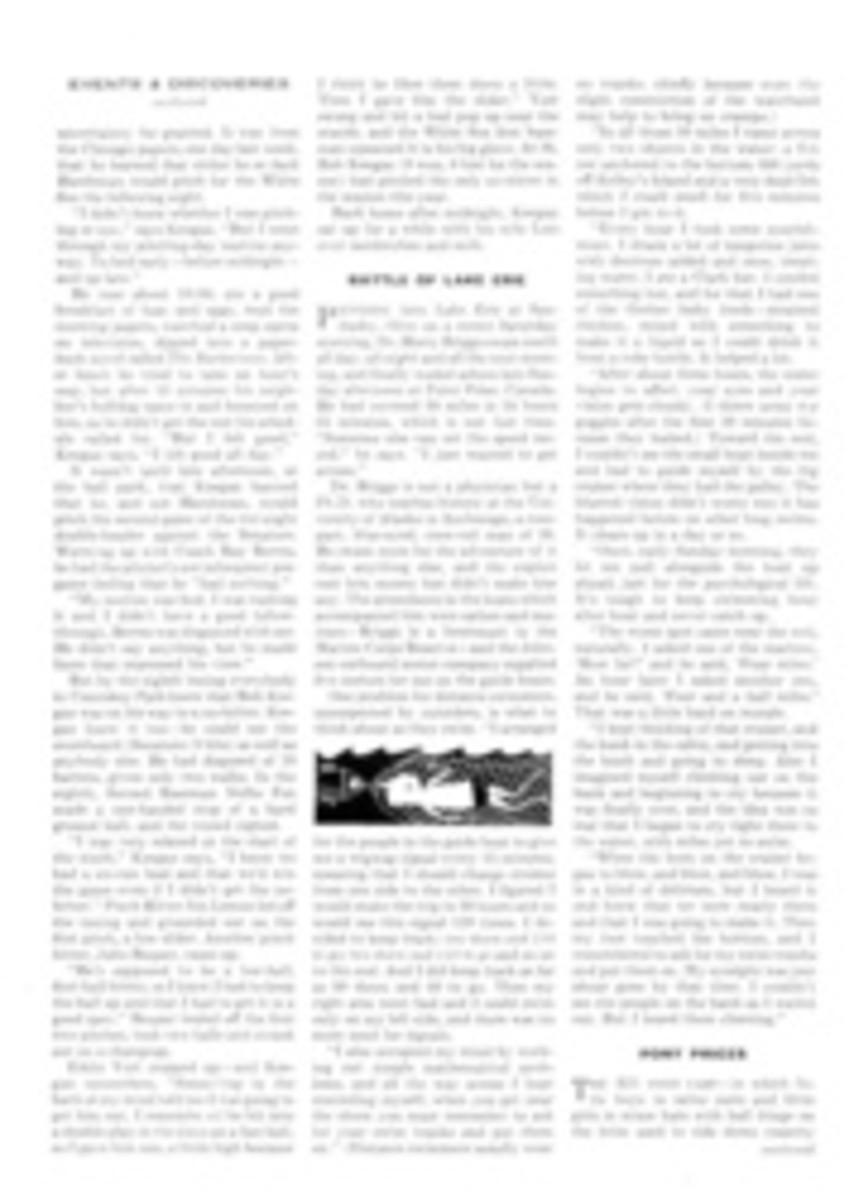
Me and Those Canoes
Canoeing was invented by the Indians for torturing captives. The Eighth Amendment prohibiting cruel and unusual punishments meant canoeing. Irvin Cobb had canoeing in mind when he wrote that sport is hard work for which you don't get paid.
Canoeists are different from ordinary people. In some cases the difference probably is a matter of courage, resolution, endurance or fortitude, but in my case it was what my old top sergeant said about a rookie who tackled all the dangerous horses. "He ain't brave," snorted the hard-boiled top. "He just don't know no better."
The fact that every time a canoeist embarks he runs a measurable risk of drowning or coronary thrombosis and a greater one of hernia or heat prostration indicates that there are things basically wrong with canoeing; it is, in fact, the most inadvisable means ever conceived for the transportation of man by his own efforts.
Take paddling. If you wanted to move a bureau, you'd stand behind it and shove it with the big muscles of your back and legs. If you had a boat instead of a bureau, you'd dig in your oars and do the same thing. But what would you think of a man who moved a bureau by sitting alongside it, a foot away, and twisting around to give it a feeble shove? If he had a canoe instead of a bureau, he'd use a paddle the same way.
Rowing with two oars drives a boat as straight as a bricklayer heading for a saloon, but paddling with a single blade zigzags a canoe like a bricklayer leaving a saloon. The beginning of the stroke turns the prow aside, so to keep from traveling in a circle the paddler must end the stroke by turning his blade and pushing with it sideways, away from him. That off-center body twisting and straining is man-killing. An AAU official has said that the nearest a man can come to the pangs of childbirth is the twisting and wrenching of competition walking, but he's wrong. The agony of paddling against a headwind is like giving birth to cement blocks.
Carrying a canoe over portages hurts less than paddling only because it is done less. Any carrying at all is too much; there is no, repeat no, canoe light enough for portaging. There is one that weighs only 45 pounds, although it is aluminum, and a careless fisherman in an aluminum canoe sounds like two skeletons wrestling on a tin roof; but even that is too heavy, and besides, a canoe is three times too long to be carried through brush without catching and hanging up worse than a militia officer's saber.
The difference between canoeists and other people is emphasized again in the matter of white water. Canoeists ascend, and sometimes descend, rapids by poling. Unlike the paddler, the poler stands up to the job, but he not only reaches over the edge of the boat—he leans over it. The results of throwing one's weight on a pole which then slips are dramatic but not necessarily enjoyable.
Poling downstream can be even more dramatic and even less enjoyable. The standing poler shoves his pole ahead, sets the point and then snubs the canoe, letting it downstream slower than the current. The exciting part is when the pole sticks fast among the rocks. If the poler lets go, or if he holds on and the pole breaks, the canoe is out of control until he can squat and grab a paddle—usually too late. But if he hangs on and the pole doesn't break, the canoe goes ahead without him and he remains in the middle of a roaring torrent, waving like a flag. He can try to walk ashore or he can take a chance and let the current carry him down through the rapids, but most well-travelled stretches of white water are studded with canoe poles thrumming in the current, still supporting the skeletons of polers who held on until they starved to death.
With the paddle, white water must be run faster than the pace of the current, to maintain steering way. Since this ordinarily amounts to 10 miles an hour or more, a loaded canoe which encounters a granite mountain in the midst of a rapids is likely to absorb so many foot-pounds of energy that it abandons its unity like a dropped watermelon. For these reasons most canoeists carry around most rapids, black flies or no black flies. Some make a point of never doing so, but they are not numerous; they keep getting used up.
It is not surprising that a sport which makes such demands on its devotees should boast its full share of characters. Three of them, all identified with the canoeing craze of the '80s and '90s, are fair examples. They are MacGregor, Bishop and Nessmuk.
John MacGregor, a brawny (168 pounds) Scots barrister, started it all back in 1865 by designing a wooden kayak that fitted him like a coat (his words) or a coffin (my words) and made history as the Rob Roy. With a Cambridge hard straw hat on his hard head, a folded raincoat to sit on and his Sunday suit—and damned little else—in a folded cloth bag, MacGregor cruised on the Continent for three months, fascinating children with gifts of rubber bands, petrifying the yokels with the spectacle of burning magnesium and handing out evangelical tracts. On his return he set the sporting world afire by writing: A Thousand Miles in the Rob Roy Canoe on Rivers and Lakes of Europe and, subsequently, The Rob Roy on the Baltic and The Rob Roy on the Jordan, Nile, Red Sea and Gennesareth &c. The cheerful, hardy, sincere and most engaging personality which these fascinating books reflect was undoubtedly the principal instigation of the worldwide canoe craze that ensued.
It came to America in 1871 when a group led by William Livingston Alden and M. Roosevelt Schuyler organized the New York Canoe Club and built a fleet from drawings of Nautilus, a modified Rob Roy, which they obtained from MacGregor's first disciple, Warrington Baden-Powell. In 1885 the club established the New York Canoe Club International Challenge Cup for decked sailing canoes, which is still in competition.
In the winter of 1874-75 an early member of the New York CC, Nathaniel Holmes Bishop, rowed a canoe from Troy, N.Y. to Florida down the coastal inland waterways, and in the following winter rowed a Barnegat sneak box—a light cedar duck boat—from Pittsburgh to Florida via the Mississippi and the Gulf. The two trips aggregated about 5,000 miles, and since Bishop had earlier walked across South America from Buenos Aires to Valparaíso, it must be judged that he was obsessed with distance. He weighed but 135 pounds, and no wonder. Bishop was the real founder, in 1880, of the American Canoe Association which today is still the governing body of organized canoeing. He wrote three uninspired chronicles of his journeyings, none of them improved by his dissertations as an amateur geographer but all reflecting his courage and resolution.
Our third character is Nessmuk—George Washington Sears, the foremost outdoors writer of the 1880s. All the early canoeists were fanatical on the subject of saving weight, but Nessmuk made a religion of lightness, perhaps because he weighed only 105 pounds. He was the creator and high priest of the go-light craze in camping out.
Beginning in 1880 he and his builder, Rushton of Canton, N.Y., created a series of clinker-built wooden canoes, the first of which weighed 18 pounds and the last, built in 1885, just an ounce under 10 pounds. But his best-known craft, approaching MacGregor's 80-pound Rob Roy in fame, was the Sairy Gamp, 10½ feet long, 26 inches wide and less than 7 inches deep. Her sides could be sprung like a cardboard box by mere hand pressure and her planking was less than a quarter-inch thick, but Nessmuk cruised her all through the Adirondacks without mishap. She hangs today in the Smithsonian Institution, a miracle of cabinetwork and varnish, a cedar bubble that floats on the water as a soap bubble floats on velvet.
Aside from the barrel-hoop and bed-sheet canoes that all boys build, my own connection with this fascinating craft began with a $25 no-name and ended with an Oldtown guide model in which my bride and I honeymooned on Barnegat Bay. I had sport in all of them, but just as there is no kiss like a first kiss, so there is no canoe like the first one. That cheap but sturdy craft gave two 17-year-old boys an unforgettable summer during which we furrowed Long Island Sound like a cornfield. In that great burst of exaltation the true philosophy of canoeing—and of canoeists—was made clear to me.
On July 4, 1910 my cousin and I started before daylight to cross the sound to Execution Light but the wind came up with the sun and stalled us within pistol-shot of our goal. So we made a grand swooping run back to the sheltered inlet beside Travers Island, summer home of the New York Athletic Club, and hung around the rest of the day taking in the Metropolitan Senior High-Diving Championships more enjoyably than those who had paid to watch from land.
The wind died as darkness fell. A string orchestra struck up on the veranda of the club house, and richly garbed ladies and gentlemen began arriving in their Rolls-Royces from their lordly estates. Rare wines and costly viands were served, fragrant Havanas ignited.
By contrast, we had half a pound of smoked beef, a box of soda crackers and a jar of water. We still had before us the long paddle home, a two-mile carry on our sunburned shoulders and, for me, three hours on trolley and subway to farthest Flatbush.
I washed down the last salty, crumby mouthful with a long swig of warm water and lit my pipe. The music wafted soft and sweet as a baby's sigh over water which stirred gently as it slept in the arms of the land. The trees were inky against a spangled, luminous sky. The reek of salt marshes mingled with the pungence of the tobacco.
My fingers felt thin and hard as I wrapped them around the shaft of the gleaming spruce paddle and I was eager for long steady stroking in the balmy evening air. I was a king, and my hard bow seat was a throne on the top of the world. I pointed with my paddle at the veranda.
"Frank, I feel sorry for those people," I said with the earnestness of one who has just seen the true light. "We have everything that they have! We're enjoying ourselves more than they are; and," I added, subconsciously recalling my salary of $11 a week, "it isn't costing us a cent."
I believed it then and I believe it, every word of it, yet. And if you can't believe it, take my advice and forget about canoes. Which demonstrates that so far as I am concerned, a canoeist is unflatteringly different from other people. I'm sure you will agree when I add that I never could learn to swim.

